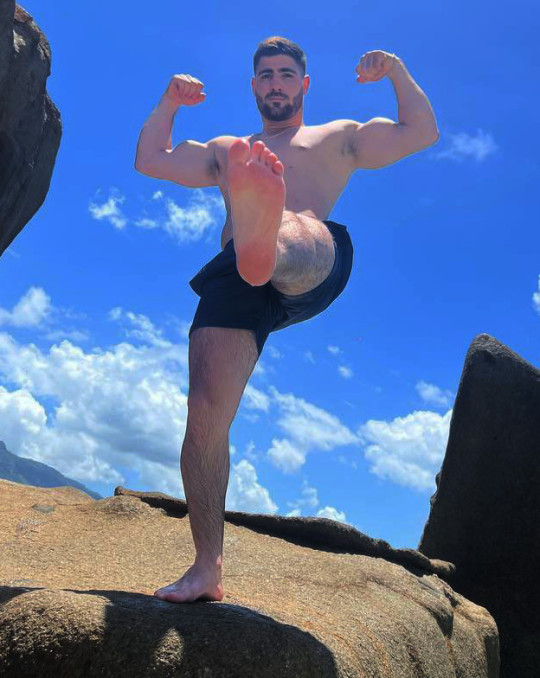#Amit Israeli
Text

Maisie Williams by Amit Israeli
45 notes
·
View notes
Text

Maisie Williams for the Mazi Coat Campaign November 2023 photographed by Amit Israeli
37 notes
·
View notes
Photo

Rebecca Leigh Longendyke by Amit Israeli 2018
65 notes
·
View notes
Photo

Amit Israeli
19 notes
·
View notes
Text

Beabadoobee for D la Repubblica June 2022 by Amit Israeli
11 notes
·
View notes
Text

L’Officiel Hommes Italia October 2016 - Dwight Hoogendijk photographed by Amit Israeli
0 notes
Text
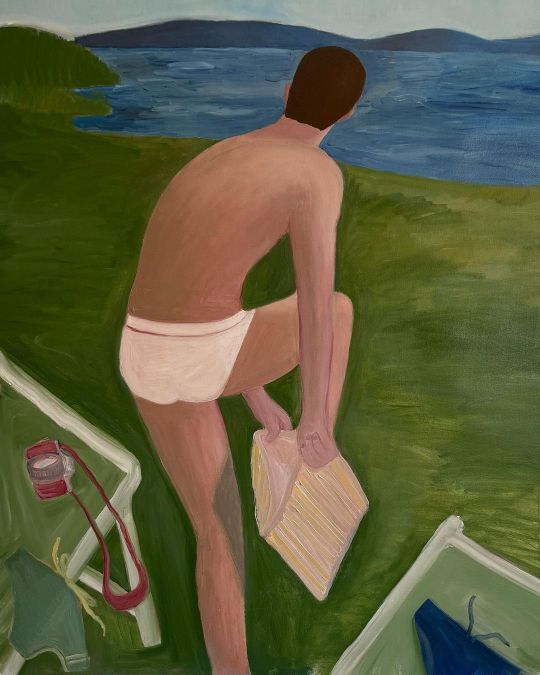
Amit Berman, The Lake of Involuntary Thoughts, 2023
Oil on canvas, 120 x 90 cm
74 notes
·
View notes
Text
where are all the ghouls who said they didn't have to believe that there was sexual violence against israeli women because there weren't any individual accusers?
the ghouls who ignored the witness testimony from the morgues, who ignored the UN report.
where are they?
15 notes
·
View notes
Text
"Every Second Seemed Like An Eternity" Says Former Hamas Captive Amit Soussana - I24NEWS
https://www.i24news.tv/en/news/israel-at-war/survivor-testimonies/1706554836-every-second-seemed-like-an-eternity-says-former-hamas-captive-amit-soussana
0 notes
Photo

Beabadoobee by Amit Israeli
66 notes
·
View notes
Text
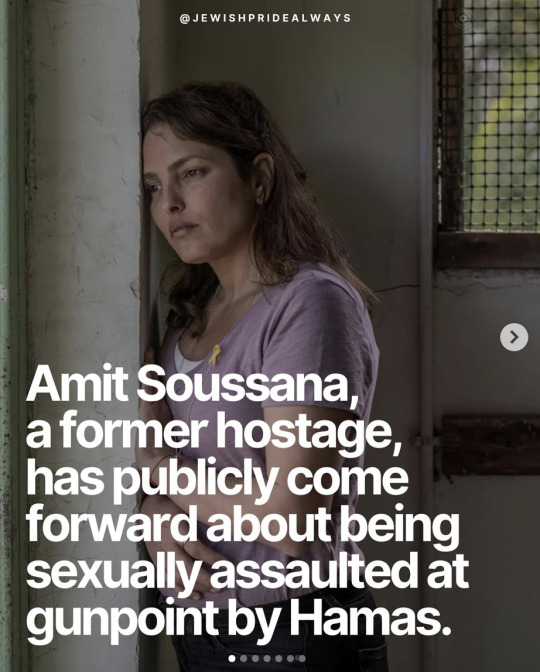






Supporting victims of sexual assault includes standing with Israeli victims. Stand with Amit. Share her voice. There are still 100+ Israelis being held hostage in Gaza. Speak up.
jewishpridealways
#Israel#October 7Massacre#HamasKidnappers'HamasSexualViolence#selectiveoutrage#injustice#MeToo_UNless_UR_A_Jew#SpeakUp#BringThemHomeNow
417 notes
·
View notes
Text
Who are the hostages still held by Hamas?
On October 7, 2023, 253 Israelis and foreign nationals were kidnapped to Gaza by Hamas and gazan civilians. Since then, 105 were released in a prisioner exchange deal, 4 were released by Hamas and 3 were rescued.
However, 134 remain in captivity (4 of those were kidnapped prior to 2023). A recent investigation has concluded that more than a fifth of the hostages are dead and the fate of some other hostages remains unknown. This video explains how doctors determine which hostages are dead, based on the nature of their injury and by analyising footage and the victims' last phone calls. Additionally, during the operation in Gaza, the IDF has recovered the bodies of a few victims and returned to their families for burial.
Since I couldn't find this all in one place, I've compiled a list of: 1) hostages who are presumed alive; 2) hostaged whose death has been reported/confirmed; 3) hostages who were released or rescued. In the group of hostages presumed to be alive who haven't been released, the youngest is 1-year-old Kfir Bibas and the oldest hostage is Iraqi-born 85-year old Shlomo Mansour.
As we learn more information, I'll continue to update this post.
They need to come back home. I'm hoping for more successful rescue operations soon. Keep them in your thoughts.

Hostages still held by Hamas (presumed alive or fate unknown):
(1) (2) (3)
Abraham Eitan Mor (23)
Abraham Munder (79)
Agam Berger (19)
Alex Danzig (75)
Alexander (Sasha) Trupanob (28)
Alexander Lobanov (32)
Almog Meir Jan (21)
Almog Sarusi (26)
Alon Ohel (22)
Amit Buskila (28)
Amiram Cooper (85)
Andrey Kozlov (27)
Arbel Yehoud (28)
Ariel Bibas (4)
Ariel Cunio (26)
Avera Mengistu (37) – Has been held hostage since 2014
Avinathan Or (30)
Bar Kupershtein (22)
Bipin Joshi (23)
Carmel Gat (39)
Chaim Peri (79)
Chanan Yablonka (42)
Daniel Gilboa (19)
David Cunio (33)
Dolev Yehoud (35)
Doron Steinbrecher (30)
Dror Or (48)
Edan Alexander (20)
Eden Yerushalmi (24)
Eitan Horn (37)
Eli Sharabi (51)
Eliya Cohen (26)
Elkana Bohbot (34)
Elyakim Libman (24)
Evytar David (23)
Gadi Moses (79)
Gali Berman (26)
Guy Gilboa-Dalal (22)
Hamzah Al-Zayadni (22)
Hersh Goldberg Polin (23)
Hisham al-Sayed (35) - Has been held hostage since 2015
Yair Horn (45)
Idan Shivi (28)
Itzhak Gelenter (56)
Itzhk Elgarat (68)
Kaid Farhan Elkadi (53)
Karina Ariev (19)
Kfir Bibas (1)
Lior Rudaeff (61)
Liri Albag (18)
Matan Angrest (21)
Matan Zangauker (24)
Maxim Herkin (35)
Michel Nisenbaum (59)
Muhammed Alatrash (40)
Naama Levy (19)
Nadav Popplewell (51)
Nimrod Cohen (19)
Noa Argamani (26)
Oded Lifshitz (83)
Ofer Kalderon (53)
Ohad Ben Ami (55)
Ohad Yahalomi (49)
Omer Neutra (22)
Omer Shem Tov (21)
Omer Wenkert (22)
Omri Miran (46)
Or Levy (33)
Ori Danino (24)
Oryon Hernandez (30)
Rom Braslavski (19)
Romi Gonen (23)
Ron Benjamin (53)
Sagui Dekel-Chen (35)
Samuel Keith Siegel (64)
Segev Kalfon (25)
Shiri Bibas (32)
Shlomi Ziv (40)
Shlomo Mansour (85)
Tal Shoham (38)
Tamir Nimrod (19)
Tsachi Idan (51)
Yagev Buchshtab (34)
Yagev Kirsht (34)
Yarden Bibas (34)
Yoram Metzger (80)
Yosef Al-Zayadni (53)
Yosef Ohana (23)
Ziv Berman (26)

Hostages confirmed/reported dead:
(Note: I couldn't find a report with the full list, but if you google each individual name you can find sources.)
Alon Shamriz (26) – Mistakenly killed by the IDF
Arye Zalmanovich (85) - Death reported by Hamas. He was forced to appear in a propaganda video.
Asaf Hamami (41)
Aviv Atzili (49)
Daniel Oz (19) - Killed on Oct. 7. Status updated on 25/02/24
Daniel Perez (22) - Killed on Oct. 7. Status updated on 17/03/24
Dror Kaplun (68)
Eden Zecharya (28)
Eitan Levy (53)
Elad Katzir (47) - Murdered by the Palestinian Islamic Jihad. His body was recovered in Khan Yunis. Status updated on 06/04/24.
Eliyahu Margalit (75)
Gad Haggai (73)
Guy Iluz (26)
Hadar Goldin (32) - Body held hostage since 2014
Ilan Weiss (56)
Inbar Haiman (27)
Itay Chen (19) - Killed on Oct. 7. Status updated on 12/03/24.
Itay Svirsky (35) – Killed by Hamas in captivity. His body was shown in a propaganda video
Joshua Loitu Mollel (21) – A released video shows how he was brutally murdered by a group of men on October 7
Judy Weinstein (70)
Kiril Brodski (19)
Maya Goren (56)
Mordechai Yonathan Samerano (21) - His body was taken to Gaza
Nik Beizer (19)
Noa Marciano (19) – Her body was found near the Al-Shifa hospital
Ofir Tzarfati (27)
Ofra Keider (70)
Oren Goldin (34)
Oron Shaul (30) – Body held hostage since 2014
Ran Gvlli (24)
Ravid Katz (41)
Ron Scherman (19)
Ronen Engel (54)
Sahar Baruch (24) – Killed by Hamas during a failed hostage rescue operation
Samer Talalka (22) – Mistakenly killed by the IDF
Shay Levinson (19)
Shani Louk (22) - Body taken to Gaza
Tal Chaim (42)
Tamir Adar (38)
Tomer Ahimas (20)
Uriel Baruch (35) - Status updated on 26/03/24
Yair Yaakov (59) – Sons and girlfriend were released; murdered on Oct. 7
Yehudit Weiss (65) – Her body was found near the Al-Shifa hospital
Yossi Sharabi (53) – His dead body was shown in a propaganda video
Yotam Haim – Mistakenly killed by the IDF
Ziv Dado (36)


Released/rescued hostages:
(1) (2)
Abigail Edan, 4, American citizen
Ada Sagi, 75
Adi Shoham, 38
Adina Moshe, 72
Agam Goldstein-Almog, 17
Aisha Ziyadne, 17
Alma Avraham, 84
Alma Or, 13
Amit Shani, 15
Amit Soussana, 40
Anucha Angkaew
Aviv Asher, 2, German citizen
Aviva Adrienne Siegel, 62
Bancha Kongmanee, Thai national
Bilal Ziyadne, 18
Boonthom Phankhong, Thai national
Buddee Saengboon, Thai national
Chalermchai Sangkaew
Channa Peri, 79
Chen Goldstein-Almog, 48
Clara Marman, 63, Argentine citizen
Daniel Aloni, 44
Dafna Elyakim, 15
Doron Katz Asher, 34, German citizen
Ditza Heiman, 84
Emilia Aloni, 5
Emily Toni Kornberg Hand, 8
Emma Cunio, 3, Argentine citizen
Erez Calderon, 12, French citizen
Eitan Yahalomi, 12, French citizen
Ela Elyakim, 8
Fernando Marman – Rescued by the IDF
Gabriela Leimberg, 59, Argentine citizen
Gal Goldstein-Almog, 11
Gal Tarshansky, 13
Gelienor (Jimmy) Pacheco, 37, Filipino national
Hagar Brodetz, 40
Hanna Katzir, 77
Hila Rotem Shoshani, 12
Ilana Gritzewsky Kimchi, 30
Irena Tati, 73, a Russian citizen, was included on the list but released separately from the exchange deal.
Itay Regev Jerbi, 18
Juckapan Sikena
Judith Raanan, 59 [Released 22/10/23]
Karina Engel-Bart, 51, Argentine citizen
Keren Munder, 54
Komkrit Chombua
Kong Saelao
Liam Or, 18
Liat Beinin Atzili, 49, American citizen
Luis Har – Rescued by the IDF
Manee Jirachart
Margalit Mozes, 78, German citizen
Maya Regev Jirbi, 21
Meirav Tal, 53
Mia Leimberg, 17, Argentine citizen
Mia Shem, 21, French citizen
Mika Engel, 18, Argentine citizen
Mongkhol Phajuabboon, Thai national
Moran Stela Yanai, 40
Natalie Raanan, 17 [Released 22/10/23]
Nattaporn Onkaew
Natthawaree Moonkan, Thai national
Naveh Shoham, 8
Nili Margalit, 41
Noam Avigdori, 12
Noga Weiss, 18
Noam Or, 17
Noralin Babadilla, 60, born in the Philippines
Nurit Cooper [Released 24/10/23]
Ofri Brodetz, 10
Ohad Munder, 9
Or Yaakov, 16, German citizen
Ori Megidish – Rescued by the IDF
Oriya Brodetz, 4
Owat Suriyasri, 40, father of two
Ofelia Adit Roitman, 77, born in Argentina
Ofir Engel, 17, Dutch citizen
Paiboon Rattanin
Pattanayut Tonsakree
Phonsawan Pinakalo
Ra’aya Rotem, 54
Raz Ben-Ami, 56, German citizen
Rimon Kirsht Buchshtav, 36
Raz Asher, 4, German citizen
Ron Krivoi, 25, an Israeli-Russian citizen, was included on the list, although he was released separately from the exchange deal.
Ruth Munder, 78
Sahar Calderon, 16, French citizen
Santi Boonphrom, Thai national
Sapir Cohen, 29
Shani Goren, 29
Sharon Aloni-Cunio, 34, Argentine citizen
Sharon Hertzman Avigdori, 52
Shiri Weiss, 53
Shoshan Haran, 67
Surin Kesungnoen
Tal Goldstein-Almog, 8
Tamar Metzger, 78
Uthai Sangnuan, Thai national
Uthai Thunsri, Thai national
Wichai Kalapat, 28, Thai national
Wichian Temthon
Withoon Phumee, 33, Thai national
Yaffa Adar, 85
Yagil Yaakov, 12, German citizen
Yahel Shoham, 3
Yarden Roman-Gat, 35, German citizen
Yelena Trupanov, 50, a Russian citizen, was included on the list but released separately from the exchange deal.
Yocheved Lifshitz [Released 24/10/23]
Yuli Cunio, 3, Argentine citizen
Yuval Brodetz, 8
Yuval Engel, 12, Argentine citizen
#israel#october 7#hamas hostages#hostages#bring them home now#jumblr#compiling all their names was a really emotional process. i did this the day before it was announced yair yaakov was murdered#and had trouble opening the file again#praying and hoping for the rest of the hostages' safe return#please let me know if i made any mistakes and/or forgot any names#as i've said in the post - a lot of info was scattered and i'm afraid i might have missed something#note: 253 was the total number i found in most reports. i don't know if it'll change at the end of the war - since some people were#considered to be held hostage and sadly later it was found they had been killed on oct 7 inside israel#like clemence felix mtenga
449 notes
·
View notes
Text
The reporters interviewed Amit Soussana for eight hours and doctors she spoke with immediately after her release. They also reviewed medical records, videos, text messages and photographs.
Full text under the cut.
March 26, 2024
Amit Soussana, an Israeli lawyer, was abducted from her home on Oct. 7, beaten and dragged into Gaza by at least 10 men, some armed. Several days into her captivity, she said, her guard began asking about her sex life.
Ms. Soussana said she was held alone in a child’s bedroom, chained by her left ankle. Sometimes, the guard would enter, sit beside her on the bed, lift her shirt and touch her, she said.
He also repeatedly asked when her period was due. When her period ended, around Oct. 18, she tried to put him off by pretending that she was bleeding for nearly a week, she recalled.
Around Oct. 24, the guard, who called himself Muhammad, attacked her, she said.
Early that morning, she said, Muhammad unlocked her chain and left her in the bathroom. After she undressed and began washing herself in the bathtub, Muhammad returned and stood in the doorway, holding a pistol.
“He came towards me and shoved the gun at my forehead,” Ms. Soussana recalled during eight hours of interviews with The New York Times in mid-March. After hitting Ms. Soussana and forcing her to remove her towel, Muhammad groped her, sat her on the edge of the bathtub and hit her again, she said.
He dragged her at gunpoint back to the child’s bedroom, a room covered in images of the cartoon character SpongeBob SquarePants, she recalled.
“Then he, with the gun pointed at me, forced me to commit a sexual act on him,” Ms. Soussana said.
Ms. Soussana, 40, is the first Israeli to speak publicly about being sexually assaulted during captivity after the Hamas-led raid on southern Israel. In her interviews with The Times, conducted mostly in English, she provided extensive details of sexual and other violence she suffered during a 55-day ordeal.
Ms. Soussana’s personal account of her experience in captivity is consistent with what she told two doctors and a social worker less than 24 hours after she was freed on Nov. 30. Their reports about her account state the nature of the sexual act; The Times agreed not to disclose the specifics.
Ms. Soussana described being detained in roughly half a dozen sites, including private homes, an office and a subterranean tunnel. Later in her detention, she said, a group of captors suspended her across the gap between two couches and beat her.
For months, Hamas and its supporters have denied that its members sexually abused people in captivity or during the Oct. 7 terrorist attack. This month, a United Nations report said that there was “clear and convincing information” that some hostages had suffered sexual violence and there were “reasonable grounds” to believe sexual violence occurred during the raid, while acknowledging the “challenges and limitations” of examining the issue.
After being released along with 105 other hostages during a cease-fire in late November, Ms. Soussana spoke only in vague terms publicly about her treatment in the Gaza Strip, wary of recounting such a traumatic experience. When filmed by Hamas minutes before being freed, she said, she pretended to have been treated well to avoid jeopardizing her release.
Ms. Soussana said she had decided to speak out now to raise awareness about the plight of the hostages still in Gaza, whose number has been put at more than 100, as negotiations for a cease-fire falter.
Hours after her release, Ms. Soussana spoke with a senior Israeli gynecologist, Dr. Julia Barda, and a social worker, Valeria Tsekhovsky, about the sexual assault, the two women said in separate interviews with The Times. A medical report filed jointly by them, and reviewed by The Times, briefly summarizes her account.
“Amit spoke immediately, fluently and in detail, not only about her sexual assault but also about the many other ordeals she experienced,” Dr. Barda said.
The following day, on Dec. 1, Ms. Soussana shared her experience with a doctor from Israel’s National Center of Forensic Medicine, according to the center’s medical report, which was reviewed by The Times.
Siegal Sadetzki, a professor at Tel Aviv University medical school who is helping and advising Ms. Soussana’s family as a volunteer, said Ms. Soussana first told her about the sexual assault within days of her release. Professor Sadetzki, a former top Israeli health official, said Ms. Soussana’s accounts have remained consistent.
Ms. Soussana also spoke to the U.N. team that published the report on sexual violence, but The Times was unable to review her testimony.
A spokesman for Hamas, Basem Naim, said in a 1,300-word response to The Times that it was essential for the group to investigate Ms. Soussana’s allegations, but that such an inquiry was impossible in “the current circumstances.”
Mr. Naim cast doubt on Ms. Soussana’s account, questioning why she had not spoken publicly about the extent of her mistreatment. He said the level of detail in her account makes “it difficult to believe the story, unless it was designed by some security officers.”
“For us, the human body, and especially that of the woman, is sacred,” he said, adding that Hamas’s religious beliefs “forbade any mistreatment of any human being, regardless of his sex, religion or ethnicity.”
Mr. Naim criticized The Times for insufficient coverage of Palestinian suffering, including reports of sexual assault by Israeli soldiers on Palestinian women, which have been the subject of investigations by U.N. officials, rights groups and others. He also said “civilian hostages were not the target” of the raid and said “we have from the first moment declared our readiness to release them.”
A Hamas planning document found in one village shortly after the Oct. 7 raid, which was reviewed by The Times, said: “Take soldiers and civilians as prisoners and hostages to negotiate with.” Video from Oct. 7 shows uniformed Hamas militants abducting civilians.
The Abduction
Ms. Soussana lived alone in a cramped single-story home on the western side of Kibbutz Kfar Azza. After hearing sirens warning of rocket attacks on Oct. 7, she said, she sheltered in her bedroom, which was also a reinforced safe room. From her bedroom, Ms. Soussana listened as the attackers’ gunfire grew closer.
The small kibbutz stands roughly 1.5 miles from Gaza, and it was one of more than 20 Israeli villages, towns and army bases overrun that day by thousands who surged across the Gazan border shortly after dawn. Some 1,200 people were killed that day and about 250 abducted, Israeli officials say, setting off a war in Gaza that local health officials say has killed at least 31,000 Palestinians.
Ms. Soussana was at the kibbutz almost by chance. Sick with a fever, she had been recuperating the previous day in the nearby city of Sderot, with her mother, Mira, who pressed her to stay the night. But Ms. Soussana drove home to Kfar Azza to feed her three cats, she said.
The youngest of three sisters, Ms. Soussana had grown up in Sderot. She qualified as a lawyer at a local college and worked for a law firm specializing in intellectual property. Her colleagues considered her a diligent, quiet and private person who kept her distance, her supervisor, Oren Mendler, said in an interview. In Kfar Azza, Ms. Soussana said, she rarely involved herself in village life and was not part of the local WhatsApp groups, which left her unaware of the extent of the attack on the kibbutz.
At 9:46 a.m. that day, she heard gunmen outside, prompting her to hide inside her bedroom closet, according to messages on her family WhatsApp group reviewed by The Times. Twenty minutes later, her phone died.
Moments later, “I heard an explosion, a huge explosion,” she said. “And the second after that, someone opened the closet door.”
Dragged from the closet, she said, she saw roughly 10 men rifling through her belongings, armed with assault rifles, a grenade launcher and a machete.
Part of the house was on fire — a blaze that would ruin the building.
Over the next hour, the group dragged her through a nearby field toward Gaza. Security footage from a solar farm near the kibbutz, which was widely circulated on the internet, shows the group repeatedly tackling her to the ground as they struggled to restrain her. At one point, a kidnapper picked her up and slung her across his back. The video shows her flailing so hard, her legs thrashing in the air, that the man tumbled to the ground.
“I didn’t want to let them take me to Gaza like an object, without a fight,” said Ms. Soussana. “I still kept believing that someone will come and rescue me.”
The Abuser
The kidnappers attempted to restrain her by beating her and wrapping her in a white fabric, the video shows. Unable to subdue her, the attackers tried and failed to carry her by bicycle, she said. Finally, they bound her hands and feet and dragged her across the bumpy farmland into Gaza, she said.
She was badly wounded, bleeding heavily, with a split lip, she said. The hospital report prepared shortly after her release said that she returned to Israel with fractures in her right eye socket, cheek, knee and nose and severe bruising on her knee and back. The report stated that several injuries were related to her abduction on Oct. 7, including punches to her right eye.
After reaching the edge of Gaza, Ms. Soussana said, she was shoved into a waiting car and driven a few hundred yards into the outskirts of Gaza City. She was untied, dressed in a paramilitary uniform and transferred to another car filled with uniformed militants. A hood was placed over her head, though she could still catch glimpses of her surroundings from under it, she said. After a short drive, she was hurried up a staircase and onto a rooftop, she said.
After the hood was removed, Ms. Soussana said, she found herself in a small structure built on the roof of what she would later realize was an upscale private home. She remembered that militants were busy taking more guns from a box. Then the gunmen hurried downstairs, and she was left alone, facing a wall, with a man who said he was the owner of the house and called himself Mahmoud, she recalled.
“After a couple of minutes, he said I can turn around,” Ms. Soussana said. “And I was shocked,” she added. “I find myself sitting in a house in Gaza.”
She said Mahmoud was soon joined by a younger man, Muhammad. She remembered Muhammad as a chubby, balding man of average height with a wide nose.
Later that day, they dressed her in a thick brown garment that covered her body, she said. They gave her three pills, which they said were painkillers. It was the only time that she remembers receiving any kind of medicine in Gaza, let alone medical treatment.
Fitted with a fan and a television, the room appeared to have been prepared for her arrival, she said. There were three mattresses, she said, one for her and two for the guards.
Early in her captivity, her guards chained her ankle to the window frame, she said. Around Oct. 11, she said, she was led by the chain to a bedroom downstairs. She understood that it belonged to one of Mahmoud’s sons, and that his family had been moved to another place.
The chain was reattached to the door handle, she said, next to a mirror. For the first time since her capture, she could see what she looked like.
“I saw the chains and I saw that my face was all swollen and blue,” she said.
“And I just started to cry,” she said. “This was one of the lowest moments of my life.”
The Jail
For the next two and a half weeks in October, Ms. Soussana said, she was guarded exclusively by Muhammad.
She recalled that the room was almost permanently shrouded in darkness. The curtain was usually drawn shut and there were rolling power outages for most of the day, she said.
She said Muhammad slept outside the bedroom, in the adjacent living room, but frequently entered the bedroom in his underwear, asking about her sex life and offering to massage her body.
When he took her to the bathroom, Ms. Soussana said, he refused to let her shut the door. After giving her sanitary pads, Muhammad seemed particularly interested in the timing of her period, she said. She said she had spoken in a mix of basic English and Arabic; she had learned a little Arabic at school and her mother’s family — Jews from Iraq — had sometimes spoken it during her childhood.
“Every day, he would ask: ‘Did you get your period? Did you get your period? When you get your period, when it will be over, you will wash, you will take a shower and you will wash your clothes,’” Ms. Soussana recalled.
When it arrived, Ms. Soussana said, she was exhausted, afraid and undernourished; her period lasted just one day. She managed to convince him that her menstruation continued for nearly a week, she said.
She tried to humanize herself in his eyes by asking the meaning of Arabic words she heard on television. She also promised that her family would reward him financially if she was returned without further harm to Israel, she said.
In the afternoons, two associates of Muhammad would join him at the apartment, bringing him a cooked meal, she said. Some of this food was given to her as her one meal of the day.
The Israeli strikes on the neighborhood became more frequent and frightening, Ms. Soussana said, noting that some shattered the windows. As the bombing intensified, she said, she started feeling sorry for the civilians, wondering why Hamas had never built bomb shelters for its people.
“I felt for them,” Ms. Soussana said. “Just think about growing up like this — it’s scary.”
The Assault
Early on the morning of the assault, she said, Muhammad insisted she take a shower, but she refused, saying the water was cold. Undeterred, he unchained Ms. Soussana and brought her to the kitchen and showed her a pot of water boiling on the stove, she said.
Minutes later, he brought her to the bathroom and gave her the heated water to pour over herself, she said.
After washing for a few minutes, she heard his voice again from the door, she said.
“‘Quickly, Amit, quickly,’” she recalled him saying.
“I turned around and I saw him standing there,” she said. “With the gun.”
She remembered reaching for a hand towel to cover herself as he advanced and hit her.
“He said, ‘Amit, Amit, take it off,’” she recalled. “Finally, I took it off.”
“He sat me on the edge of the bath. And I closed my legs. And I resisted. And he kept punching me and put his gun in my face,” Ms. Soussana said. “Then he dragged me to the bedroom.”
At that point, Muhammad forced her to commit a sexual act on him, Ms. Soussana said. After the assault, Muhammad left the room to wash, leaving Ms. Soussana sitting naked in the dark, she said.
When he returned, she recalled him showing remorse, saying, “I’m bad, I’m bad, please don’t tell Israel.”
That day, Muhammad repeatedly returned to offer her food, Ms. Soussana said. Sobbing on the bed, she turned down the initial offerings, she said.
Knowing that Ms. Soussana craved sunlight, she said, he refused to open the curtains, leaving the room in darkness. Desperate for daylight, she accepted the food, believing that she had no other option but to placate her abuser.
“You can’t stand looking at him — but you have to: He’s the one who’s protecting you, he’s your guard,” she said. “You’re there with him and you know that every moment it can happen again. You’re completely dependent on him.”
The Israelis
Ms. Soussana said her captors moved her away from the border after a major, hourslong bombardment overnight. Based on the extent of the explosions and snippets she caught on television, she later concluded it was around the start of Israel’s ground invasion of Gaza on Friday, Oct. 27.
On the following day, she was hurried into a small white car, she said. The driver headed southwest toward what she would later be told was the central city of Nuseirat.
“Muhammad is sitting in the back seat next to me, and with the gun pointed at me,” she said.
The car stopped outside what looked like a United Nations school and Ms. Soussana was ushered into a busy street, she recalled.
She said she was handed over to a man who called himself Amir. He marched her up the stairs of a nearby apartment block and into another private home, she said.
For the first time in weeks, she was free of Muhammad — but terrified to be entering yet another unknown. “‘Oh my God,’” she remembered wondering. “‘What’s going to happen to me?’”
The man ushered her into a bedroom and shut the door behind her, she recalled. Inside, she found two young women playing cards, next to an older man lying on a bed and an older woman sitting in a chair, she said. Ms. Soussana was wearing traditional clothes from Gaza, she recalled.
“They looked at me and I looked at them, for like half a minute,” she said. “Then I asked, ‘Are you Israelis?’”
“Are you Israeli?” Ms. Soussana remembered one of the women replying.
The Tunnels
Three weeks after her kidnapping, Ms. Soussana had been united with four other hostages. Hugging them, Ms. Soussana broke down in tears, she said.
The identities of the four others were shared with The Times on the condition that their names would not be used to protect those still in captivity.
A few days after her arrival, she was summoned to the apartment’s living room, Ms. Soussana recalled. Amir often played here with his children.
On that day, the guards wrapped her head in a pink shirt, forced her to sit on the floor, handcuffed her, and began beating her with the butt of a gun, she said.
After several minutes, they used duct tape to cover her mouth and nose, tied her feet, and placed the handcuffs on the base of her palms, she said. Then she was suspended, hanging “like a chicken” from a stick stretching between two couches, causing her such pain that she felt that her hands would soon be dislocated.
They carried on beating and kicking her, focusing on the soles of her feet, while simultaneously demanding information they believed she was hiding from them, Ms. Soussana said.
She still doesn’t understand what exactly they wanted or why they thought she was concealing something, she said. At one point, the head guard brought over a spike, and made as if to poke her eye with it, pulling away just in time, she said.
“It was like that for 45 minutes or so,” she said. “They were hitting me and laughing and kicking me, and called the other hostages to see me,” she said.
Ms. Soussana recalled that the kidnappers untied her and returned her to the bedroom, telling her she had 40 minutes to produce the information they wanted or else they would kill her. She said one of the young women was so frightened that she asked Ms. Soussana if she had any last messages for her family.
In mid-November, the hostages were separated: The two youngest women were taken to an unknown location, she said, while Ms. Soussana and the older couple were driven to a house surrounded by farmland.
They found the house full of gunmen, who ordered them to sit on the floor. Suddenly, the older woman began to scream, Ms. Soussana said.
The woman was looking into a shaft that descended into the ground, Ms. Soussana said. “I hear one of the drivers telling her: ‘Don’t worry, don’t worry. It’s a city down there.’”
“Then I realized,” Ms. Soussana said. “We’re going into the tunnels.”
The Release
A ladder, several stairs and a series of narrow sloping passageways led the three hostages deep underground, she said.
By the time they reached the bottom, the guards said they were 40 meters deep, something they hoped would reassure the hostages, she said: The Israeli bombs could not reach them there.
Ms. Soussana said a big gunman in a mask was waiting for them at the bottom. Initially, he started shouting at them, telling them that Israel had killed his family, she said, but then quickly stopped, removed his mask and took a different tone.
She said the man introduced himself in English as Jihad and told them his father had worked in Israel and had even had his Israeli boss to dinner, in the years when Israeli civilians could still enter Gaza. He spoke in Hebrew at times. Jihad said he had learned some from watching Israeli television and sang them a famous song that he had heard on a children’s show, Ms. Soussana remembered.
“I was shocked,” Ms. Soussana said. “Suddenly, he was the most humane guy we met there.”
The ground shook every time a missile struck nearby, making her fear they might be buried alive, she said. The tunnels were dark, damp and too narrow for two people to pass each other. And their subterranean cell was so short of air that they were left dizzy and panting after taking a few steps, she said.
Israeli troops would later capture and photograph the tunnel. Ms. Soussana identified fabrics and mattresses in the pictures.
Their captors spent little more than an hour a day in the tunnel, ascending to higher levels overnight for fresh air, Ms. Soussana said. The hostages pleaded with the guards to bring them, too.
After several days, the kidnappers gave in, brought them back to the surface and drove them to another private house, Ms. Soussana said.
They were still there when Israel and Hamas agreed to a hostage deal and a temporary truce, which went into force on Friday, Nov. 24. The following day, the three hostages were driven to an office in Gaza City — Ms. Soussana’s final detention site.
Every day brought hope and disappointment. It was never clear which hostages would be freed, or when.
On Thursday, Nov. 30, which turned out to be the last full day of the truce, the guards were making lunch when one of them finished a phone call and turned to Amit.
“He says: ‘Amit. Israel. You. One hour,’” Ms. Soussana recalled.
Within an hour, Ms. Soussana said, she was separated from the older hostage and driven through Gaza City. The car stopped, and a woman in a hijab climbed inside. It was another Israeli hostage: Mia Schem, who was also being released.
They were taken to a junkyard, Ms. Soussana recalled. Around them, she said, their guards changed from civilian clothes into uniforms.
Finally, the two women were driven to Palestine Square, a major plaza at the heart of Gaza City, where a raucous crowd waited to see them handed over to the Red Cross. Social media video showed that Hamas struggled to control the onlookers, who surrounded the car, pressed up against its windows and at one point began to rock the vehicle, Ms. Soussana said.
After a tense few minutes, the Red Cross officials managed to transfer the women to their jeep.
As they approached the Israeli border, a female Red Cross official handed Ms. Soussana a phone. A person who said he was a soldier greeted her in Hebrew.
“He said, ‘A couple more minutes and we’re going to meet you,’” Ms. Soussana said. “I remember, I started to cry.”
Aaron Boxerman and Isabel Kershner contributed reporting.
Patrick Kingsley is the Jerusalem bureau chief, covering Israel and the occupied territories. He has reported from more than 40 countries, written two books and previously covered migration and the Middle East for The Guardian. More about Patrick Kingsley
Ronen Bergman is a staff writer for The New York Times Magazine, based in Tel Aviv. His latest book is “Rise and Kill First: The Secret History of Israel’s Targeted Assassinations,” published by Random House. More about Ronen Bergman
A version of this article appears in print on March 27, 2024, Section A, Page 1 of the New York edition with the headline: Israeli Hostage Tells of Sexual Assault in Gaza. Order Reprints | Today’s Paper | Subscribe
254 notes
·
View notes
Text
#i stand with israel#israel#pray for israel#israel is under attack#hamas is isis#bring them home now#hamas attack#hamas massacre#hamas war crimes#pro israel
222 notes
·
View notes
Text
Daily update post:
Since this morning, Hezbollah has been firing rockets at Israel's northern towns. There is at least one man dead, identified as 25 years old Zahara Bashar, an Israeli Druze, and 2 people injured as a result of this on going attack.
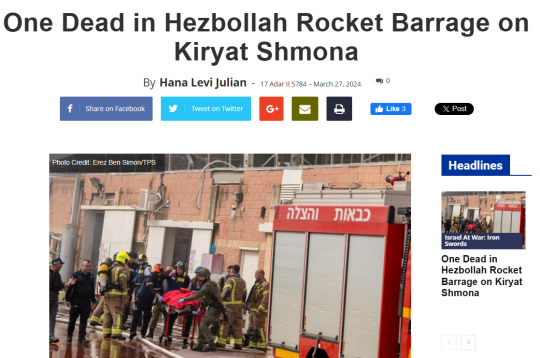
This is a reaction by Iran-funded Hezbollah to a strike by Israel yesterday on a different terrorist organization, al-Jama’a al-Islamiyya (the Islamic Assembley, an ally of al-Qaeda), and following even more Israeli military activity in Lebanon, meant to stop a senior member of Fatah (the ruling party of the Palestinian Authority) from smuggling Iranian-funded standard explosives and additional weapons into Israel for terrorist attacks. As one TV military reporter I was listening to yesterday explained, the difference between improvised explosives and standard ones is in how lethal they are, for example when a small amount is attached to the side of a vehicle, the difference is whether one person gets killed or ten.
youtube
I've written about Israel still waiting for definitive proof that Marwan Issa, Hamas' #3 in Gaza, has been killed in a military strike. Yesterday, we got an official confirmation of that. This means that out of the 4 Hamas leaders that are on the top of Israel's list, two are gone. We're still left with Yahya Sinwar (#1) and Mohammed Deif (#2). Most Israelis tend to think that if Israel manages to kill Sinwar, Hamas will likely surrender, and the war would be over.

As Israel's military operation in the Shifa hospital continues, here is a really important batch of testimonies from captured terrorists, about how, once the IDF left this place, they returned to it, exploited it assuming they'd be safe there, and how they were not alone, with defined areas for the Hamas terrorists, and others meant for the Palestinian Islamic Jihad (PIJ) terrorists, cynically using spots such as the maternity ward.
youtube
A military reporter published the fact that Israel has refused permission for Turkey and Qatar to participate in air drops of humanitarian aid into Gaza. The reporter frames it as a political decision, but consider what it means that Qatar and Turkey are both politically hostile countries - that there is no way for Israel to verify they would not try to air drop military aid to Hamas. At the same time, I wanna highlight what this info also means, and hasn't been talked about... It means that every time you hear about yet another country air dropping aid into Gaza, that's done with Israel's permission. And there are way more countries permitted to do this than refused. This is one of many things that should make it clear that Israel is NOT targeting regular Gazans, and is making every possible effort to make sure they are getting humanitarian aid, while trying to minimize how much this aids Hamas (and in that sense, prolongs the war).

These are brothers Neria and Daniel Sharabi.
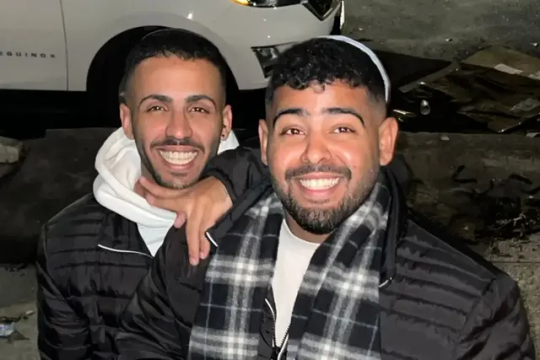
On Oct 7, they were at the Nova music festival. Not only did they survive Hamas' massacre, they also helped to save others. Since then, they've started a fund to help the survivors, and in order to raise money, they've been traveling abroad, telling their story, mostly to Jewish communities. A couple of days ago, they were traveling to Manchester, in the UK, when they were asked at the airport upon arrival what their religion was. They recount that after disclosing they were Jews and what they were there to do, they encountered hostile reactions, including being told (according to a TV interview I heard with them), "We don't like what you're here to do," and "We have to make sure that you are not going to do here what you are doing in Gaza." They were detained for a couple of hours, before being allowed in. The brothers said they're convinced this was motivated by antisemitism based on being questioned about their religion. The incident is said to be investigated.
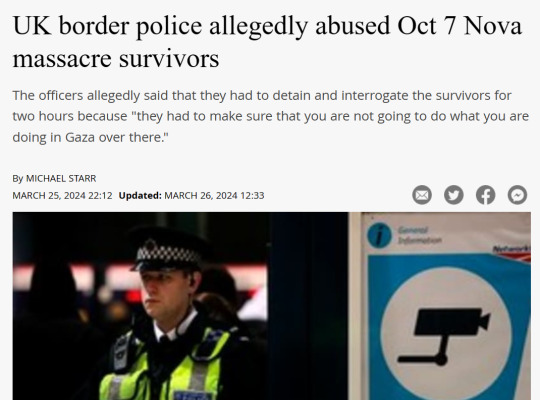
This is 40 years old Amit Soussana.

She was kidnppaed to Gaza from her home in kibbutz Kfar Azza, and among the hostages released in late November. A lot of Israelis remember her as the hostage who was captured on film trying to fight off the men taking her, with no less than 7 of them (yes, Israelis have counted) involved in her abduction:
We've had private testimonies from Israelis about having been raped, we've had public testimonies from Israeli who have seen the physical evidence of the Hamas rapes, we've had public testimonies of Israelis who have witnessed those rapes, and we've had public testimonies of hostages, who've heard from their fellow captives about the sexual abuse the latter have gone through. All that wasn't enough for some people, who continued to deny Hamas' sexual violence. Now, Amit Soussana is the first Israeli to come forward and publicly talk about the sexual assault she had suffered at the hands of Hamas. Her testimony has been published in the New York Times, and for anyone without a subscription, other publications have quoted parts of it, like Times of Israel. A part of me really hates that Amit might have felt compelled to speak because of the doubt cast at raped Jews. Another part thinks that for the second time, she is showing outstanding bravery. And yet another finds it hard to believe that this will make a difference. Those who are dead set on not believing Jews, essentially calling us all liars, will do the same to her, and when they do, I hope she won't have to witness that firsthand. But in a sense, if their doubt is indeed the reason why she felt she had to speak up publicly, then it's clear that there's already been damage done to the victims of Hamas' sexual violence.
This is 35 years old Uriel Baruch with his son.
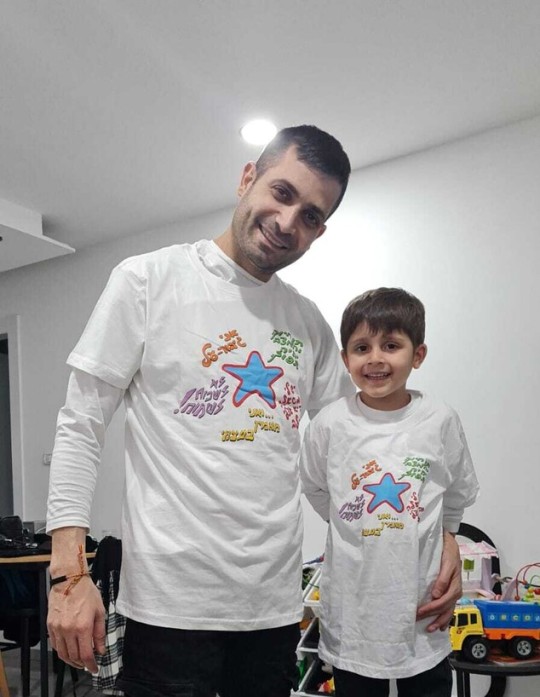
Uriel was married, and a father of two. He loved techno music, and on Oct 7 was attending the Nova music festival along with a friend, Michael Yoav, who was murdered there (his body was found shot in the car in which the two were trying to escape). Uriel was kidnapped. Yesterday, the army was able to confirm to the family that Hamas had murdered him while in captivity, and is still holding Uriel's body hostage. The number of Israeli hostages in Gaza is 134, and the official confirmations of death indicate that no more than 98 are still alive, though some count Hamas claims as well, in which case no more than 96 are. May Uriel's memory be a blessing.
(for all of my updates and ask replies regarding Israel, click here)
#israel#antisemitism#israeli#israel news#israel under attack#israel under fire#terrorism#anti terrorism#hamas#antisemitic#antisemites#jews#jew#judaism#jumblr#frumblr#jewish#israelunderattack#resources
112 notes
·
View notes
